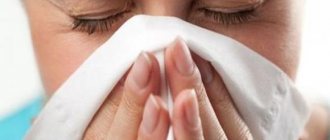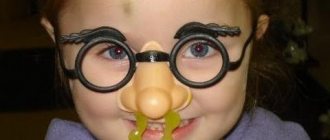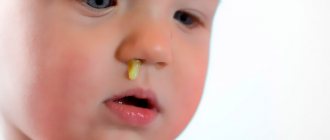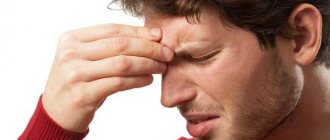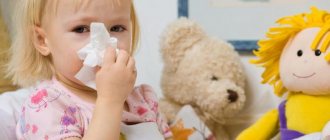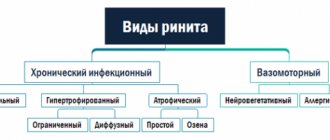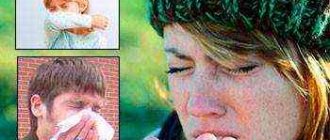Comparison of drugs
Rinofluimucil is a drug that has anti-inflammatory, mucolytic (thin and accelerates the removal of sputum), anti-edematous and local vasoconstrictor effects.
Isofra is an antibacterial drug with a broad spectrum of action (affects most strains of bacteria).
Compound
- Rinofluimucil - in the composition of this drug, the main active ingredients are: acetylcysteine and tuaminoheptane sulfate. Also, to give a pharmacological form, additional substances are used.
- Isofra - in this medicine, the active ingredient is framycetin sulfate. Additional substances are used to give the pharmacological form.
Mechanism of action
- Rinofluimucil - acetylcysteine, one of the active components, has the ability to break disulfide bridges (covalent bonds between sulfur atoms in amino acids), which helps to liquefy sputum and increases the rate of its discharge. Acetylcysteine also has an anti-inflammatory effect due to the inhibition of enzymes responsible for inflammation. Tuaminoheptane sulfate here acts as a local vasoconstrictor component necessary to relieve edema.
- Isofra, the active component of this drug, framycetin, is capable of breaking the cell walls of pathogenic (disease-causing) microorganisms, destroying its integrity, which ultimately leads to the death of the bacterium. This substance has a bactericidal (bacteria-destroying) effect on most gram-positive and gram-negative strains of pathogens.
Indications
- Acute form of rhinitis (runny nose) with viscous, difficult to separate sputum;
- Chronic form of rhinitis with purulent viscous sputum;
- Allergic rhinitis;
- Sinusitis (inflammation of the sinuses);
- Vasomotor rhinitis (chronic inflammation of the nasal mucosa, characterized by copious secretion of mucus).
- Polypous rhinitis (difficulty in the outflow of mucus due to a polyp in the nasal passages).
- Acute forms of rhinitis (bacterial);
- Acute forms of nasopharyngitis (bacterial inflammation of the nasal passages and pharynx);
- Sinusitis (bacterial).
Contraindications
- Hypersensitivity to the components of the drug;
- Thyrotoxicosis (increased amount of thyroid hormones);
- Angle-closure form of glaucoma (increased intraocular pressure and, as a consequence, visual impairment);
- Arterial hypertension (high blood pressure);
- Taking antidepressants.
- Hypersensitivity to aminoglycosides (antibiotics).
Side effects
- Arterial hypertension;
- Tachycardia (increased heart rate);
- Psychomotor agitation;
- Tremor (involuntary twitching of the limbs);
- Local allergic reactions (dry nasal mucosa, inflammation of the sebaceous glands).
- Allergic reactions as a result of individual intolerance to aminoglycosides (redness, itching, skin rash).
Rinofluimucil or Isofra - which is better?
When choosing a drug to treat a runny nose, you should first pay attention to the nature of the disease. If rhinitis is of viral etiology (origin), then Rinofluimucil should be used. This remedy is effective for rhinitis, sinusitis, and other inflammations of the mucous membranes of the nasal passages, the source of which is acute respiratory viral infections. It will effectively thin mucus, speed up its removal from the nasal cavity, and also make breathing easier by relieving inflammatory swelling.
If rhinitis, sinusitis, or other diseases have a bacterial etiology, the use of Isofra is necessary. Since this drug is an antibiotic, it will fight directly against the source of the disease - pathogenic microorganisms.
The use of Isofra for rhinitis of viral etiology is pointless, since the treatment will not have the desired effect.
Thuja occidentalis oil
If the inflammatory process in the nasal cavity is accompanied by adenoiditis, then it is recommended to include thuja oil in the complex treatment of green snot. The effect of thuja oil is multifaceted. Evergreen thuja in homeopathic dilutions can eliminate inflammation, stop the growth of tumors, restore local immunity, thereby healing the nasopharynx from ailments.
Green snot in children due to adenoids is not uncommon, so stabilizing adenoid vegetations and reducing their size will help save the child from a recurrence of bacterial rhinitis.
The therapy also includes the homeopathic drug thuja occidentalis. Treatment usually lasts a minimum of 3 months. The child is prescribed homeopathic peas 12 times a week. Classical homeopaths will most likely suggest a 50 or 200 dilution. If the effect of the drug is noticeable, the frequency of taking homeopathic peas will be reduced.
To the delight of parents, after treating green snot with thuja preparations, children often got rid of relapses of tonsillitis, adenoiditis, and pharyngitis.
Note! Making your own medicines from thuja is not safe, because... Trees and shrubs of the cypress family are poisonous plants.
An article on the topic of how to use thuja oil for adenoids in children.
Isofra and Rinofluimucil together
Since these drugs have completely different active ingredients, the mechanism of their effect on the body is also different. Thanks to this, combined (joint) administration of these funds is possible.
The use of these medications will be advisable for severe forms of rhinitis, sinusitis and nasopharyngitis, exclusively of a bacterial nature with purulent, difficult to separate viscous sputum. The antibiotic included in Isofra will fight the source of the disease - bacteria, and Acetylcysteine, included in Rinofluimucil, will dilute viscous sputum and accelerate its elimination.
source
How does the product work?
Rinofluimucil contains two active components - acetylcysteine and tuaminoheptane. The first ingredient helps cleanse the nasal passages of mucus and secretions, as it liquefies them and facilitates their removal to the outside. Tuaminoheptane is a pressor amine (an organic substance derived from ammonia), its main effect is to constrict blood vessels in the nasal cavity. This leads to a decrease in the secretory activity of glands affected by viruses or bacteria.
Both components mutually enhance each other's activity. As a result of a complex local effect on the nasal cavity, the drug has the following effects:
facilitates nasal breathing; cleanses the lumens of the nose; removes pathological contents; reduces inflammation activity; reduces the amount of nasal discharge; relieves swelling of the mucous membrane.
Download instructions for use →
The drug alleviates the baby’s condition: the child begins to breathe freely through his nose, and the discharge stops.
User comments
Isofra, Polydex - for purulent snot. Before doing this, be sure to rinse your nose, vasoconstrictor as necessary.
If the nose is so stuffy that rinsing and vasoconstrictors do not help, then you need to do a cuckoo.
In my opinion, I would also add a mucus thinner.
Maybe you should go to an ENT specialist for a fee?
What is a cuckoo? The pediatrician actually told us that once she gets better, we should go to the ENT specialist, she suspects adenoids
Cuckoo is when you rinse your nose with saline under pressure. It is poured into one nostril and pulled out from the other using a special apparatus.
Your pediatrician is simply a “miracle”, he suspects adenoids, but how to treat?
I will share my experience, if you allow. My son is often sick, and he was also diagnosed with grade 2-3 adenoids. When I asked that my son did not snore at night and was breathing freely, they shrugged, and the local ENT specialist generally told me to prepare for surgery. I found a practicing ENT specialist through connections, he examined my son, said how you can see the adenoids, I, in turn, assured that no one had examined my son like that. As a result, grade 1-2 adenoids and adenoiditis were diagnosed, due to which Leo constantly had purulent snot. He then prescribed protargol, half a pipette to each nostril - otherwise, in his words, you are treating a runny nose, not adenoids. No sooner said than done, he assured that the effect should be enough for at least 3 months, pah-pah, it’s been normal since the summer. Of course, there are no fewer colds, but there are no more purulent snot.
source
Effective Application
The drug carries out its treatment with the help of acetylcysteine content, as well as with the help of tuaminoheptane.
It is these components, which are the main ones in its composition, that are responsible for reducing certain swelling in some glandular formations. If you are being treated with a drug such as Rinofluimucil, it is worth keeping in mind that it is very important to simultaneously find out from your doctor how to treat incipient sinusitis in other ways. Since you cannot rely only on this drug and take only it. Yes, it is strong, but alone it cannot completely affect the bacteria of the disease.
If the disease has already begun to develop, it is not always possible to cure it with Rinofluimucil alone.
This drug is available exclusively in spray form. It should be used intranasally. All adults and children can be treated with a drug called Rinofluimucil, but only if the children are over three years old. If one of the parents decides to treat the child with this remedy, it should be done in consultation with the doctor.
What are the symptoms of sinusitis in a 6-year-old child will become clear when you read this article.
Rinofluimucil can be used for no more than 7 days
Rinofluimucil should be used in both nostrils. But you need to know the dose, because it is selected individually for each person. For example, doctors recommend that adults use the spray three or four times a day. The injection into one nostril must be done twice in one approach. As for children, it is also necessary to apply three to four times a day, but the injection into one nostril must be done only once.
You can understand how to quickly treat sinusitis at home by reading this article.
Treatment with the drug Rinofluimucil should not last more than a week. Otherwise, addiction to one of the components of this drug is possible. Only a doctor can prescribe treatment with Rinofluimucil for more than a week.
Once the spray bottle is opened, it must be used for no more than 20 days. After this period, the bottle can be thrown away. This is justified by the fact that the medicine will be unsuitable for use.
What is better and more effective Isofra or Rinofluimucil?
It is very unpleasant to be next to a person with a stuffy nose, who constantly “sniffs.” It’s even more unpleasant to be in this person’s place. But since this inevitably affects everyone, it is necessary to have in your home medicine cabinet medications that help eliminate symptoms and have a therapeutic effect.
For example, Isofra and Rinofluimucil - any of them can be prescribed by your doctor or suggested by a pharmacist. Having examined each one separately, it will become clear what they are and which one to give preference to.
Isofra - a drug for the common cold
The drug is produced in France. Provided in spray form. In the pharmacological group it is on a par with antimicrobial, antiparasitic, antibiotics, aminoglycosides.
For local use only. The active substance is framycetin sulfate : 1 ml of spray contains 12.5 mg of the substance.
The liquid is clear and without any particular odor. It has few side effects - allergic reactions.
Framycetin has a suppressive effect on various microbes. The therapeutic effect is carried out due to the direct effect on the cells of the mucous membranes of the nasal passages and paranasal sinuses.
The bactericidal effect extends to different strains of microorganisms. The latter have virtually no resistance to the main substance. Due to this, infection of the upper respiratory tract is suppressed.
The drug Isofra does not penetrate into the general bloodstream, acting at the local level - inside the nose.
To achieve the desired dosage, it is necessary to make several preliminary sprays. When administering the medicine, the head should be slightly tilted forward.
The doctor determines the duration of treatment and dosage. Standard dosage for adult patients: 1 press into each nasal passage up to 6 times a day.
Rinofluimucil - a remedy to combat purulent nasal discharge
The drug is produced in Italy. Provided in the form of a nasal spray. In the pharmacological group it is on a par with decongestants.
For local use only. Active ingredients: acetylcysteine (1.0 g), tuaminoheptane (0.5 g).
The liquid is not cloudy and smells like mint. Adverse reactions are extremely rare:
- Allergy.
- Cardiopalmus.
- Overexcitement.
- Increased blood pressure.
- Tremor in hands.
- Dryness of the mucous membranes of the nasopharynx.
- Enlarged sebaceous glands.
The drug has mucolytic properties due to acetylcysteine. It thins out pus and mucus discharge. In addition, it relieves inflammation and is an antioxidant.
Tuaminoheptam has a constricting effect on blood vessels at the local level. Due to this, swelling and redness of the mucous membrane are reduced.
While maintaining a certain dosage, none of the active substances penetrates into the general bloodstream.
The medicine is administered using a nebulizer into each nasal passage.
Recommended dose for adults: 2 pumps up to 4 times/day. For children: 1 press up to 4 times / day. Course up to 7 days.
Tuaminoheptam may cause overdose if recommended doses are not followed. It is usually expressed in the form of high blood pressure, anxiety, tremors in the hands, and tachycardia. In addition, this substance is addictive.
Rinofluimucil is not prescribed in combination with tricyclic antidepressants, MAO inhibitors and blood pressure medications.
Instructions for use
Rinofluimucil is known only in the form of a nasal spray for the treatment of sinusitis, sinusitis, and acute rhinitis. Drops for sinusitis are not produced under this name, since this dosage form is less effective than a spray. This product can be used by adults and children.
Children over 2 years old should irrigate their nose with medicine, but this should only be done after consulting a pediatrician. Adults can carry out spray treatment for the period specified in the instructions, but no longer. With prolonged use, the medicine is addictive, and in case of overdose, negative consequences can occur. It is highly undesirable to use the spray during pregnancy.
The medicine is prescribed to women carrying a child only in extreme cases, and it can only be used in a hospital setting under the supervision of a doctor. This remedy increases the tone of the uterus. Nursing mothers can use it, but breastfeeding should be stopped in this case.
How to take - dosage
The medicine is injected into the nostrils according to the scheme:
- adults – two presses on the valve in each nostril 4 times a day;
- children from 2 years old - one press on the valve in each nostril three times a day.
Treatment of sinusitis with Rinofluimucil is possible for 7 days, no more. Before use, you need to attach the sprayer to the bottle with the solution. The spray is activated by pressing the valve.
Important! The spray can only be used as prescribed by a doctor. It contains substances that can cause allergies. The effect of the drug is very strong, it is able to cleanse the maxillary sinuses in just a few injections.
In what case and for whom are the drugs best suited?
Isofra is prescribed along with other medications to patients with infections and inflammation of the upper respiratory tract.
These include inflammation of the mucous membranes without damage to the sinus walls:
- Nose (rhinitis).
- Paranasal sinuses (sinusitis, rhinosinusitis).
- Nasopharynx (rhinopharyngitis).
The drug is suitable for patients who have experienced inflammatory processes after surgery. The medicine is used for preventive purposes.
Isofra is not suitable for those who have individual intolerance to the constituent substances and antibiotics (aminoglycosides). Not used for children under one year of age, pregnant or lactating women.
Rinofluimucil is recommended for patients diagnosed with rhinitis:
- Acute stage with thick mucus and an admixture of pus.
- Subacute stage with mucus.
- Chronic stage.
- Vasomotor.
- Rhinosinusitis (inflammation of the paranasal sinuses).
Rinofluimucil will definitely not be suitable if you have a history of:
- Individual intolerance to one of the components of the drug.
- Angle-closure glaucoma.
- Thyroid diseases.
The medicine is not used if a person is treated with tricyclic antidepressants, MAO inhibitors. Or if 2 weeks have not passed after treatment.
Prescribe with caution to patients diagnosed with:
- BA (bronchial asthma).
- Increased blood pressure.
- Angina ||| -|V stage.
In the case of extrasystole, which is repeated at frequent intervals, therapy is carried out under the supervision of a specialist.
During pregnancy and breastfeeding, treatment with the drug is allowed if the benefit to the mother is higher than the risk to the child. Any of the drugs can be prescribed by the attending physician, after weighing the pros and cons.
source
Drops for green snot in a child: 26 medicines for children and adults
The release of watery mucus from the nose is a natural physiological process necessary to maintain the moisture of the mucous membrane and protect against pathogenic microorganisms. The appearance of thick green snot is a sign of bacterial infection due to colds, chronic rhinitis, sinusitis and other diseases.
This symptom cannot be ignored, since the infection, under the influence of provoking factors, spreads to other organs, and due to the proximity of the brain, infection can be deadly. A wide range of medications are used for treatment, most often nasal drops and sprays. They will be discussed in this article.
Drops for children from green snot
When wondering how to treat green snot, parents choose the easiest way - using nasal drops. They are distinguished depending on the effect they provide: antiseptic, irrigating, antibacterial, etc. Each remedy fights the disease in its own way, but before purchasing and using it is advisable to consult a pediatrician. The doctor will differentiate the disease (allergic, physiological runny nose or infection), identify the provocateurs and prescribe the best medicine for green snot. Drops can be prescribed in combination.
Isofra from green snot
Treatment of green snot in a child begins with taking antibacterial agents. They are designed to eliminate the causative agent of the disease: bacteria that provoke purulent rhinitis. The list of modern medications in this group includes Isofra nasal spray. Its cost varies from 150 to 200 rubles. How should they treat green purulent snot in a child? The instructions say:
- The drug is taken in a course of up to 7 days.
- Multiplicity – 3-4 injections per day.
- Before use, the nose is cleared of accumulated mucus (by rinsing or irrigating drops: Aqualor, Aquamaris).
Polydex for green snot
Polydex drops (spray) are a multifunctional medicine that combines an antibiotic, a vasoconstrictor and a hormone. It is prescribed for prolonged colds, adenoiditis, sinusitis, and otitis media. If a child is bothered by green snot, treatment is carried out with Polydexa, but with the permission of the pediatrician. The list of contraindications includes: children under 2.5 years of age, so it is not recommended to prescribe it yourself, even with advanced rhinitis. For young patients, the course of taking the drug: up to 5 times a day for 5-8 days. Cost of the medicine: 350-400 rubles in different pharmacy chains.
What is green snot
Nasal secretions are produced by the nasal mucosa throughout life. Normally, they are transparent and have a uniform structure. The appearance of green snot indicates an infection in the respiratory tract. The mucus becomes thick, sometimes blood particles appear, and there may be a foul odor. The characteristic yellow-green purulent tint is given by the remains of dead lymphocytes and waste products of microorganisms.
The shade of the discharge depends on the stage of the runny nose and the severity of the infectious process. This symptom occurs equally in both children and adults and requires immediate medical attention.
What good nasal medications do adults and children take for treatment?
A wide range of nasal drops are used to treat purulent rhinitis. They are usually prescribed in combination, which allows you to relieve associated symptoms (stuffiness, swelling and inflammation of the nose), as well as destroy the causative agent of the infection. The most important drugs to combat green snot are antibiotics. As an additional measure, irrigating compositions, vasoconstrictor drops, antiseptics, hormones and homeopathy are prescribed.
Read more about how to treat green ones in this article.
Irrigating agents for congestion
They allow you to moisturize the nasal mucosa, wash away particles of bacteria and help relieve congestion. They often have a soft composition, for example, ordinary sea salt water, and therefore are suitable for the treatment of purulent rhinitis in children.
Is it possible to use Aqualor spray?
Manufacturer: Sweden, the drug is produced in the form of a spray or drops for children and adults. The drops prevent the spread and occurrence of infection and facilitate nasal breathing. Suitable for daily hygiene in children from the first days of life, they have no contraindications. Aqualor contains an isotonic solution, a large amount of useful substances and microelements, and no preservatives. Used to rinse the nasal cavity 2-4 times a day.
Quicks
The product is from a German manufacturer and is available in the form of drops and spray. Helps moisturize and actively cleanses the nasal cavity of bacteria and impurities. The composition contains sea water from the Atlantic Ocean, there are no chemical additives. Prescribed to children from 3 months, suitable for the treatment of runny nose during pregnancy. The optimal dosage is 2-3 instillations per day. Price – from 360.
How to rinse your sinuses with Aqua Maris solution
Croatian drug prescribed for the treatment and prevention of all types of rhinitis. Helps thin nasal mucus and normalizes its production by goblet cells of the mucous membrane. Composition: purified and sea water from the Adriatic Sea. The drops are suitable for children from 1 year of age and can be used in any trimester of pregnancy. Instillations are carried out 2-4 times a day. Cost – from 200 rubles.
Aqua Maris is one of the first pharmaceutical products based on sea water. Widely used in many countries around the world; drops can be found in almost any pharmacy.
Nasal rinsing with Dolphin
The domestic product Dolphin for irrigation of the nasal cavity is available in the form of a powder for preparing a solution; the kit also includes a device for rinsing. Suitable for the treatment and prevention of purulent rhinitis for adults and children over 12 years of age. The composition contains sea water, soda, rosehip and licorice extracts. To use, 1 packet of the product must be dissolved in warm water and irrigated each nostril using the device. The optimal dosage is 2-3 procedures per day.
Correct dosage
As a rule, pharmacies sell aqueous solutions of the substance that have a concentration of 20 or 30%.
Albucid with a higher concentration should be dripped with considerable caution, especially in newborns - despite the fact that these eye drops do not interfere with normal activities in adults, in children they can cause severe irritation of the mucous membrane.
In addition, it is worth making sure that the child can be given these drops and that he does not have an individual intolerance to the active substance - therefore, the final decision on use should be made solely by the doctor.
From the age of one year, 1-2 drops of the drug can be administered into the nose no more than 3 times a day. Administration is carried out using a special pipette - maximum care must be taken.
If you choose the wrong concentration of the product, the child may pull away due to severe irritation of the mucous membrane, damaging the nose. Therefore, experts recommend holding the back of a small child’s head with your hand when using Albucid drops.
How to properly instill
Using drops is the most popular way to treat a runny nose. The effectiveness and efficiency of the procedure largely depends on compliance with the rules of instillation. Technology:
- You need to thoroughly clean the nasal cavity, blow your nose or rinse.
- Sit on a chair or lie on your back, tilt your head back slightly.
- Place drops into each nostril according to the dosage.
- To distribute the product over the entire surface, turn your head first to the left, then to the right. Fix your head in each position for 25-30 seconds.
To enhance the absorption of the drug, you can close one nostril with your finger and drop the drug into the second nasal passage.
Read about how to cure a chronic runny nose by following the link.
Instillation of any medications in children should only be carried out by an adult to avoid mechanical damage to the mucous membrane.
How and what to treat green snot in children
Colds and diseases of other etiologies are a constant occurrence in the cold season, and parents, in search of something to treat, often resort to proven folk remedies.
However, green snot in children means the risk of complications, so you cannot do without an ENT doctor: drops, sprays, solutions, antibiotics are prescribed depending on the cause that led to the development of the negative phenomenon.
Why does a child have green snot?
The appearance of green mucus indicates the onset of a bacterial runny nose; it is often complicated by the penetration of viruses and becomes viral-bacterial. The change in color of the discharge is due to the accumulation of dying bacteria and neutrophils in the mucus, which fought against the infection using the child’s immune system. The more pronounced the green color of the snot, the more signs of mixed type rhinitis.
The green color of thick mucus secreted from children's noses indicates the onset of various diseases:
- ARVI. Always accompanied by a runny nose, if it is not treated in a timely manner, the discharge quickly thickens and turns green.
- Physiological runny nose. It often happens in newborns, it is considered a natural process, it only requires rinsing the nose with saline, which quickly relieves the baby of a runny nose.
- Purulent rhinitis. This is a complication of a respiratory cold of viral etiology. The disease weakens the defenses of a child’s poorly formed immune system, so secondary bacterial damage occurs, the mucus thickens and turns green.
- Sinusitis. A dangerous pathology that appears if a runny nose of a primary nature has started. With sinusitis, green thick discharge quickly clogs the maxillary sinuses, children complain of pain in the bridge of the nose, along the upper jaw. Dark circles appear under the eyes.
- Allergy. The untreated form leads to thickening of the mucus and a change in its color. Then an acute infection quickly sets in, causing the formation of green mucus.
Knowing the reasons for the formation of thick green snot in a child can help in the question of how to treat rhinitis. According to Komarovsky, only the doctor should find the causes and choose the right direction of treatment.
Nasal mucus is taken for bacterial culture, and laboratory assistants determine the true disease based on the quantity and quality of protective cells.
Folk remedies
Komarovsky suggests treating green snot in a child with folk recipes. The doctor believes that if the discharge has taken on a green tint, it means that dead neutrophils are accumulating in it - and this is a sign that the baby’s own defenses are working well.
Recipes for folk remedies against green runny nose:
- Carrot and beet juice are natural antiseptics. Application: instill juice into the nose, diluted 1:1 with boiled water, 2-3 drops several times a day. At 2 years old, green snot in a child is treated by drinking additional pure juice, 1 tbsp. l. 3 times a day.
- Chamomile and calendula drops. Preparation: take 50 g of dried chamomile and calendula flowers, pour a glass of boiling water, simmer in a water bath for 20 minutes. Add 10 drops of tea tree essential oil, rosemary, and 20 drops of olive oil to the cooled broth. Application: instill into the nose 2-3 times a day.
- Pure aloe and kalanchoe juice. It is used to treat green snot in a child when he is already 3 years old. Application: drop into the nose 2-3 times a day.
Green snot in a child is treated with folk remedies, for example, rinsing the nose:
- A solution of sea salt with iodine. Preparation: take a glass of warm water, dissolve 1 tbsp in it. l. sea salt, add 1 drop of iodine. Application: rinse your nose 1-2 hours after instillation of any drops. Any rinsing, following a couple of hours after instilling the drops, quickly relieves the baby of thickened mucus.
- Infusion of chamomile, calendula, St. John's wort. Preparation: take 1 tbsp. l. each herb, mix them. Take 50 g from the mixture, add 200 ml of boiling water, leave for 2 hours. Then strain. Use: as a solution for rinsing the nose.
- A solution of fresh aloe juice in warm water. Preparation: take 1 tbsp per glass of water. l. juice, stir. Use: as a rinsing solution.
How exactly to treat green snot in a child using folk remedies is recommended by healers and herbalists. They advise using the products in alternation, so it will be clear which of them is most effective and quickly helps the baby.
How to treat green snot in a baby
A runny nose with green discharge should be treated with the help of a doctor who determines the cause of the disease and, accordingly, chooses the direction of therapy. The goal of treatment is to exclude the occurrence of serious complications in the form of prolonged otitis media and sinusitis, which are difficult to treat if the child is under 5 years old.
If a child under 1 year of age has a green runny nose, it is necessary to consult a doctor on the same day, and under no circumstances self-medicate.
How else to treat green snot in a child
The doctor chooses which medications to use in each specific case. How exactly to treat green snot in a child depends on the reasons for its appearance and the onset of the disease. Usually these are nasal drops, inhalations, rinsing, and drinking plenty of fluids.
Treatment with antibiotics
Parents often ask whether antibiotics are needed for bacterial rhinitis. Sometimes doctors prescribe drops with antibiotics - Framycetin, Isofra. They are effective, but there is no need to use them.
Ordinary purulent rhinitis, even with a severe course, is well treated with antibacterial drops. They are combined with nasal rinsing and breathing exercises.
Antibacterial drops are selected after a laboratory analysis, which shows which bacteria have infected the child’s nasal cavity. Without testing, antibiotic drops are not prescribed to a child; Dr. E. Komarovsky recognizes such treatment as inappropriate.
Is it necessary to treat with vasoconstrictor drops?
Drops that constrict blood vessels, such as Naphthyzin, Sanorin, Nazivin, Phenylephrine, Nazol, always become addictive when used in treatment for longer than 3-5 days. Pediatricians prescribe them when a child has severe nasal congestion, for a course of no more than 5 days.
Doctors are cautious about prescribing them, given that each of these drops has a whole list of side effects.
Medicines in this group are prohibited for use in the treatment of children under 2 years of age. All of them only temporarily eliminate symptoms and do not have a therapeutic effect on the causes of rhinitis, says Dr. E. Komarovsky.
Local antiseptics
Medicines containing essential oil - Pinosol, Kameton are considered local antiseptics. The result of their use is that nasal congestion goes away and bacterial rhinitis is cured. A good local antiseptic is a solution of water with fresh celandine juice: for a glass of water you need to take only 2 drops of juice, freshly squeezed from a green plant.
This remedy is used in children over 5 years of age, with caution, because the plant is poisonous. But in a situation with a green runny nose, it helps to easily cope with thickening of mucus and cleansing the child’s nose. Dr. Komarovsky usually recommends using this plant in older children.
Antihistamines
The use of antihistamines is considered mandatory in the practice of treating children with persistent green runny nose. They help relieve swelling, lacrimation, and sore throat.
The purpose of taking these medications is to minimize complications after exposure to viruses, infections, and allergens.
All antihistamines have the following effect:
- against itching;
- local anesthesia;
- against edema;
- against spasms.
Taking antiallergic medications helps prevent spasms in the bronchi, which cause thick mucus to flow along the back wall of the larynx. From the age of 1 month, babies are allowed to be given Fenistil; for older children, the pediatrician prescribes Suprastin injections.
Their analogues are Pipolfen tablets, Diprazine, Clemastine, Tavegil. Medicines are selected based on their tolerance to children, taking into account existing contraindications.
Warming ointments, patches against green snot
Many kids don’t like mustard plasters, instillation, or breathing in a nebulizer. They are saved by safe patches that are effective for rhinitis. Their effect is the evaporation of essential oils, facilitating the child’s breathing.
Types of patches:
- "Breathe"; based on essential oils of eucalyptus, mint, fir, lavender, turpentine oil, levomenthol of plant origin;
- "Snopelka"; based on camphor and eucalyptus oils;
- Magicoplast, and its variants - “For a runny nose”, “To ease breathing during a cold”. Developed with essential oils of patchouli, eucalyptus, cedar and plant levomenthol.
Patches are transdermal products intended for external use. Some of them are glued to the skin, others - to clothing or bedding. The effect of any patch is 8 hours.
There are many ointments for external use that can be used to rub the bridge of the nose and wings of the nose when there is a runny nose, preventing contact with the eyes. You can also rub the chest, but be careful in your movements on the nipples.
Types of ointments that treat green snot in children:
- "Doctor Mom";
- "Badger";
- "Teddy Bear";
- "Golden Star".
Ointments for a thick runny nose and green snot in a child are treated with folk remedies. They have a warming effect and are used as an addition to drug therapy. The pediatrician prescribes ointments for children according to age, type of drug, and special instructions for its use.
Doctor Komarovsky about green snot in a child
Evgeniy Komarovsky insists on treating thick green runny nose with bacterial preparations and excludes the use of antibiotics.
The doctor recommends not taking sick children to kindergarten or school until the green runny nose is cured. At home, the composition of mucus in the child’s nose should be normalized; sometimes this does not require medications, but favorable conditions will be created - humidified air, an air temperature of at least 18 degrees, no more than 20 degrees.
Long walks in the air, according to E. Komarovsky, are an equivalent substitute for antibiotic drops. The child needs to drink a lot, wash out the mucus from the larynx, liquefy it so that it is naturally removed from the nose.
Source: https://www.Kleo.ru/items/zdorovie/chem-lechit-zelenye-sopli-u-rebenka.shtml


